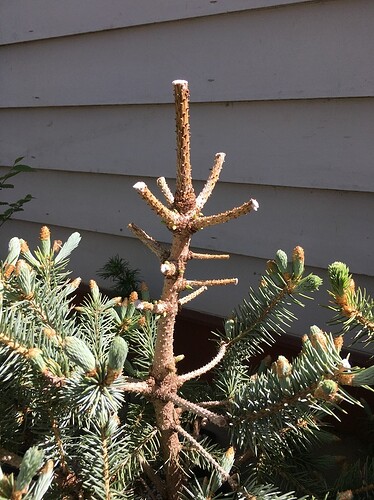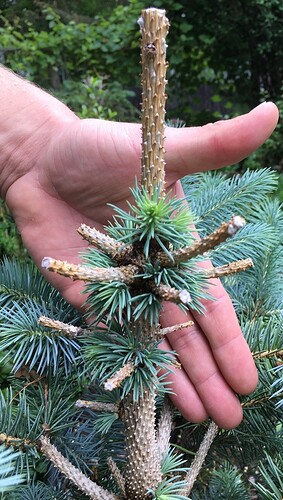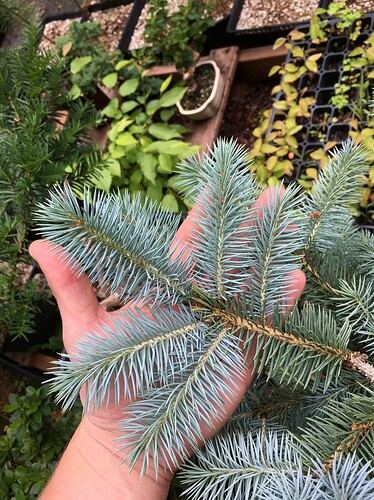Inspired by this weeks live stream, I have just been having a hack at a Spruce in development. Not sure if the cultivar, lets just call it “small needle Christmas tree.”
It was trunk chopped over 2 years ago (in the garden centre car park) about 20cm- 9” above the highest branch.
Back budding was good, so I cut back to redistribute the energy and then moved on to the dead wood above the top branch. Expecting to be scraping dried bark off, I was amazed to find the floum slip off as if had been freshly cut! Compartmentalisation had only occurred a few mm below the main chop and on the shoulders of the removed branches.
I’m wondering if anyone knows how long it would have taken for the spruce to dry off the unused section? If I was in any doubt as to weather or not spruce store energy in the vascular system, this is strong evidence.
Andy, that is an interesting observation. Can’t answer your question but someone out there might be able to. The main thing is thanks for sharing that information. That way hopefully we can all learn from contributions like your’s.
Ok, I had a very weird thing happen that is very similar to what was going on with your spruce. Last fall I bought two Colorado blue spruce from Lowe’s. They were being sold as little Christmas trees you could plant in your yard kind of a deal, so I believe I bought them in November. I did a similar style of trunk chop so to speak, where I removed all the foliage from the apex that was too tall. But I kept the wood and left the bark on as to try to limit sap loss, and figured I would go back in this year and remove the whole thing. Or just strip the dead bark off and keep the wood as a jinned apex sort of thing. Like the appearance of a tree in nature where the original apex was struck by lightning or something.
Anyways, this spring after repotting I found that this section of the tree started back budding like crazy, where all the foliage had been removed! I was so surprised because I figured it had died back down to the next green branch. Some pics.
Since I took the pictures that new growth has continued to become more vigorous. Kind of strange!
Yes @Mike_Hennigan,
My spruce did a similar thing last spring. I rubbed the buds off and thought that would be the end of it, especially because there were no high buds this years.
I’m wondering if the tree is using the top section as an extra energy store, or maybe it struggles to draw resources back down the trunk, expecting all the demand to be up to the apex?
Mike,
Did the new growth remain strong and viable? The reason I ask is because while the defoliated area could pop buds as happened in both your case and Andy’s, the key thing is if these buds continuing growing and turning into branches.
Do these cases draw a question around Ryan’s insistence that pruning doesn’t encourage back budding but strong growth on the branch does (heavy fertilization, no pinching or pruning, increased traffic of sugars and starches)? As I see it, the upper portions of both spruce were drawing a lot of traffic. The tree was programmed to send stored and generating energy to these areas and when there was no foliage to absorb it, it created it. It reminds me of how air layers produce new roots in response to a high concentration of sugars and starches that have no where to go because of the phloem and cambium removed to make the air layer. Regardless of whether this explanation holds water, back budding did occur after massive pruning.
In my opinion, it is not an either or situation of no pruning or pruning but a combination of Ryan’s approach FOLLOWED by pruning. Allowing a branch to grow out without any pruning or pinching, heavy fertilization, exposure to sunlight, CREATE the CONDITIONS for back budding which pruning later on TRIGGERS into happening. I have had a similar recent experience on some of my eastern white pine.
I should add that in Ryan’s experience it seems that the back budding occurred without pruning. But if in other cases, pruning triggered the back budding then we should acknowledge both approaches can work. And if one method doesn’t get the results, then choke up on the bat and try another.
They are continuing to grow and gain strength. Not as strong as the preformed buds where there was still foliage. But I actually did rub off a few strong preformed buds in the area before I took these pictures that may have actually formed after the pruning (I don’t remember those buds being there in the fall when I initially pruned). I’ll take some more recent photos so you can see in a couple days when I get home from vacation.
Update.
9 days after peeling the bark on my small needle Christmas tree, and I’ve just got round to carving the dead wood.
Initialy there was an accumulation of congealed sap on the surface, but upon working the wood with pliers, it turned out that under the surface the wood was tinder dry. Not surprised, as the top was cut 2 years previously, but the surface was still supple enough to pull the fibers
image|375x500
Here’s a picture of that strange backbudding from a couple days ago. I removed all of this growth right after the picture because the original pruning did was meant to kill the apex for a deadwood feature. But as you can see they have been growing pretty well, not nearly as vigorous as he normal preformed buds on the other branches though. I included a pic of these for comparison.
I was wondering if those initial buds would amount to much. Especially since all of the foliage was removed which could compromise the drawing capacity of sap flow needed to feed the newly growing buds. Looks like they had enough support for the new buds.






